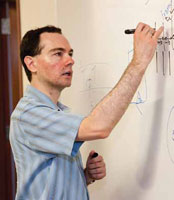Mighty Molecular Machines
UNM researchers harness the power of molecules
Molecules are the building blocks of our world. But in this age of multitasking, UNM researchers are using computer science to investigate how molecules can do much more: how they can exert their brains and their brawn.
Thinking Molecules
 For several years, Darko Stefanovic, associate professor of computer science, has used computer science and modeling techniques to investigate minute decision-making machines using molecular logic gates. Computers run on logic gates, switches that use an input, like a keystroke on a keyboard, to produce a single output. Stefanovic worked with a team of researchers from Columbia University to emulate the silicon-based decision-making devices that power current computers. They used simple logic gates made of DNA molecules that react to different inputs. The ultimate result could be a nanoscale, biocompatible computer that could live in an organism and use its DNA logic to make rudimentary decisions based on what it senses in the environment. For instance, this smart biocomputer could monitor a diabetic's glucose levels and release insulin when needed.
For several years, Darko Stefanovic, associate professor of computer science, has used computer science and modeling techniques to investigate minute decision-making machines using molecular logic gates. Computers run on logic gates, switches that use an input, like a keystroke on a keyboard, to produce a single output. Stefanovic worked with a team of researchers from Columbia University to emulate the silicon-based decision-making devices that power current computers. They used simple logic gates made of DNA molecules that react to different inputs. The ultimate result could be a nanoscale, biocompatible computer that could live in an organism and use its DNA logic to make rudimentary decisions based on what it senses in the environment. For instance, this smart biocomputer could monitor a diabetic's glucose levels and release insulin when needed.
In 2005, the team successfully demonstrated a DNA-based computing module that could play a winning game of tic-tac-toe. Now the team, along with Steven Graves, associate professor of chemical and nuclear engineering, is working on linking DNA-based logic gates to create cascades. When a specific output drives an input for another logic gate, the cascading reactions can perform complex behaviors.
"The interesting thing about the cascade is that it serves as a model for a naturally occurring, large enzymatic network," explains Stefanovic. "If we can build sufficiently large-scale networks that have interesting behaviors, they can have some functions that are akin to life."
Walking Molecules
Besides making molecules compute, Stefanovic is working with a team to make them walk and carry things. The multidisciplinary team includes computer scientists, chemists, and physicists from UNM, Columbia University, Arizona State University, and Boston University.
The team has attached four strands of DNA enzymes as "legs" on a single molecule to create a molecular walker or "spider." When the spider is placed on a surface coated with a substrate that is complementary to the DNA legs, it moves. At the nanoscale level, the molecular walker is affected by "Brownian motion," the randomized movement that happens as water molecules in solution bombard it from all sides. The research team is studying the dynamics of this diffusive motion and the interaction of the legs with the substrate in order to control the molecular walker and get it to accomplish a task. Ultimately, these spiders could be used as drug delivery devices or nanoscale sensors.
Stefanovic and Mark Olah, a UNM computer science doctoral student, are charged with developing the computer models to simulate different types of molecular walkers.
"As computer scientists, we can use our models to explore different parameters easily. We can do many simulations, find sets of parameters that move faster or more efficiently, and then share that with the chemists so they can design a spider based on them," says Olah. He is in the process of finalizing some spider models, which experimentalists on the team will use to build the molecular walkers in their labs.
Stephanie Forrest, professor and chair of computer science, sees great potential for the interdisciplinary team’s research. “By sharing ideas and techniques, these scientists and engineers are creating a versatile technology that could have wide-ranging applications. In the future, molecular computation could help keep us safe, monitor our health, and even help save the planet.”
